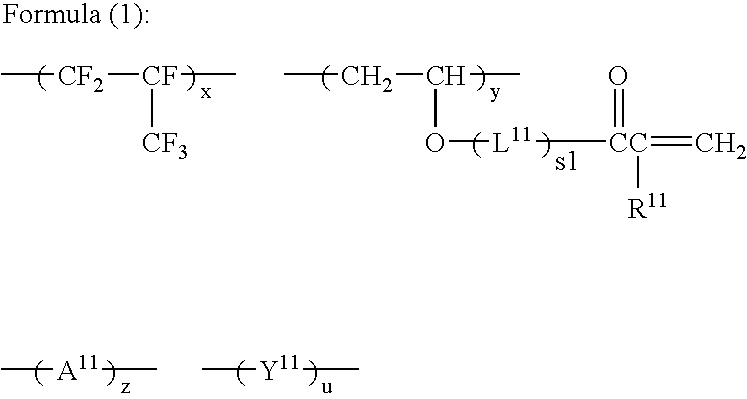Antireflection Film, Production Method Thereof, Polarizing Plate Using the Antireflection Film and Image Display Device Using the Antireflection Film or Polarizing Plate
a technology of anti-reflection film and production method, applied in the field of anti-reflection film, can solve the problems of increased production load, coating failure, insufficient scratch resistance, etc., and achieve the effect of high productivity, satisfactory anti-reflection performance and scratch resistance, and anti-fouling property
- Summary
- Abstract
- Description
- Claims
- Application Information
AI Technical Summary
Benefits of technology
Problems solved by technology
Method used
Image
Examples
example 1-1
Preparation of Sol Solution a
[0298]In a reactor equipped with a stirrer and a reflux condenser, 120 parts of methyl ethyl ketone, 100 parts of acryloyloxypropyltrimethoxysilane “KBM-5103” {produced by Shin-Etsu Chemical Co., Ltd.} and 3 parts of diisopropoxyaluminum ethyl acetoacetate were added and mixed and after adding thereto 30 parts of ion-exchanged water, the mixture was allowed to react at 60° C. for 4 hours. Thereafter, the reaction mixture was cooled to room temperature to obtain Sol Solution a. The mass average molecular weight was 1,600 and out of the oligomer or greater polymer components, the component having a molecular weight of 1,000 to 20,000 occupied 100%. Also, the gas chromatography revealed that the raw material acryloyloxypropyltrimethoxysilane was not remaining at all. Sol Solution a was adjusted to a solid content concentration of 29% by methyl ethyl ketone.
[Preparation of Coating Solution (HCL-1) for Hard Coat Layer]
[0299]2.0 Parts of polymerization initiat...
examples 1-2 to 1-5
and Comparative Examples 1-1 to 1-4
[0310]Low Refractive Index Layers (LL1-2) to (LL1-9) were formed according to
[0311]Antireflection Film Sample (101) except for changing the conditions of pre-heat treatment, UV curing and after-heat treatment as shown in Table 14 in Example 1-1, whereby Antireflection Film Samples (102) to (109) were produced.
[Saponification Treatment of Antireflection Film]
[0312]Antireflection Film Samples (101) to (109) obtained as above each was subjected to the following saponification treatment.
[0313]An aqueous 1.5 mol / liter sodium hydroxide solution was prepared and kept at 55° C. Separately, an aqueous 0.005 mol / liter dilute sulfuric acid solution was prepared and kept at 35° C.
[0314]The produced antireflection film was dipped in the aqueous sodium hydroxide solution for 2 minutes and then dipped in water to thoroughly wash out the aqueous sodium hydroxide solution. Subsequently, the film was dipped in the aqueous dilute sulfuric acid solution for 1 minute a...
examples 2-1 to 2-9
and Comparative Example 2-1
Preparation of Silica Liquid Dispersion A
[0341]28 Parts of acryloyloxypropyltrimethoxysilane “KBM-5103” {produced by Shin-Etsu Chemical Co., Ltd.}, 2 parts of tridecafluorooctyltrimethoxysilane {produced by GE Toshiba Silicones Co., Ltd.} and 1.5 parts of diisopropoxyaluminum ethyl acetate were added and mixed to 500 parts of a hollow silica fine particle sol (isopropyl alcohol silica sol, produced according to Preparation Example 4 of JP-A-2002-79616 by changing the size, average particle diameter: 40 nm, shell thickness: 6 nm, silica concentration: 20 mass %, refractive index of silica particle: 1.30) and after adding thereto 9 parts of ion-exchanged water, the mixture was allowed to react at 60° C. for 8 hours. Thereafter, the reaction mixture was cooled to room temperature and 1.8 parts of acetylacetone was added thereto. While adding cyclohexanone to 500 g of the obtained liquid dispersion to keep constant the silica content, the solvent was displaced...
PUM
| Property | Measurement | Unit |
|---|---|---|
| refractive index | aaaaa | aaaaa |
| surface free energy | aaaaa | aaaaa |
| refractive index | aaaaa | aaaaa |
Abstract
Description
Claims
Application Information
 Login to View More
Login to View More - R&D
- Intellectual Property
- Life Sciences
- Materials
- Tech Scout
- Unparalleled Data Quality
- Higher Quality Content
- 60% Fewer Hallucinations
Browse by: Latest US Patents, China's latest patents, Technical Efficacy Thesaurus, Application Domain, Technology Topic, Popular Technical Reports.
© 2025 PatSnap. All rights reserved.Legal|Privacy policy|Modern Slavery Act Transparency Statement|Sitemap|About US| Contact US: help@patsnap.com



